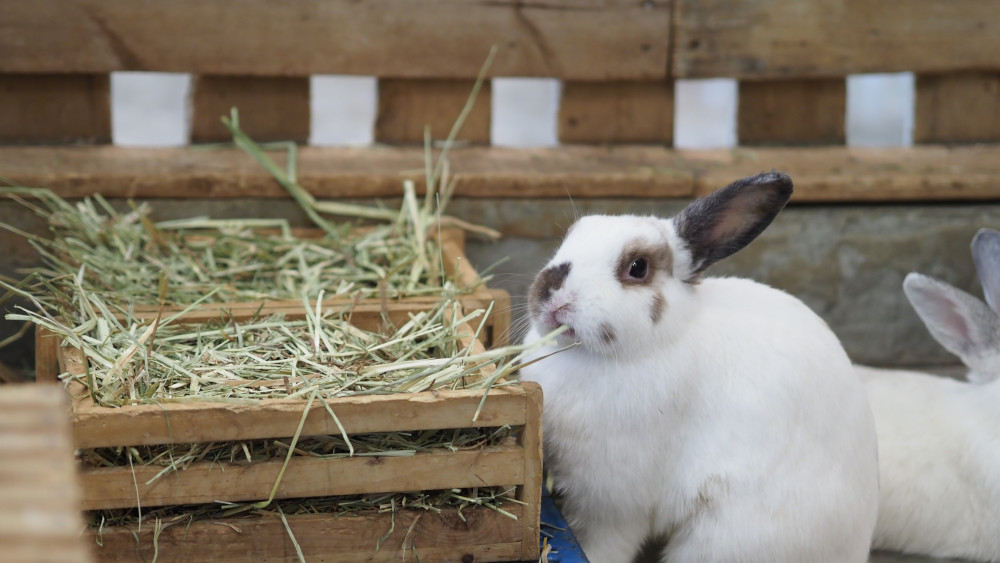
Rabbits are herbivores (they eat plant material). In the wild, they eat predominantly grass, grazing for up to 6-8 hours a day. Their whole digestive tract from their teeth right down to the end of their gastrointestinal tract is adapted to this diet and eating pattern. Providing a constant supply of grass and/or grass hay is paramount in providing a balanced diet.
Why feed hay?
Rabbits have three unique features of their digestive anatomy that makes feeding the right diet imperative.
Firstly, their teeth grow continuously – an evolutionary adaptation to a coarse fibrous diet found in the wild. In order to keep their teeth from overgrowing, rabbits chew their food in a circular direction – front to back and side to side. This brings all their teeth into wear and keeps them at the right length. This chewing motion is therefore essential for good dental health but only occurs if they spend long periods of time eating long fibrous material. Eating an excessive amount of short-length foodstuffs (such as grain, chaff, and pellets) encourages them to chew up and down like people. The teeth then don’t come into wear and dental disease develops quickly.
Secondly, fibre is needed to keep the intestinal tract moving (peristalsis). Low fibre diets can slow, or even stop, this movement. Bloat quickly develops, which is often fatal.
Thirdly, rabbits are termed ‘hindgut fermenters’, meaning that they have a large caecum (a little like our appendix but much, much bigger). Fibre is digested in the caecum (fermentation), releasing nutrients essential to their health. Without high levels of fibre in their diet, this process stops, and the rabbit weakens and dies.
What to feed
Provide a constant supply of good quality fresh grass and grass hay (this should comprise about 80% of the overall diet) – e.g. Timothy, Oaten, Wheaten, Pasture, Paddock, Meadow, or Ryegrass hays. Alfalfa (lucerne hay) is high in calcium and, while it can be offered freely to pet rabbits with higher energy needs (e.g. young rabbits and pregnant/nursing pets), it should only be offered as a treat for healthy, adult animals.
All pets benefit from some variety in their diet – for rabbits, this can be done by varying the type of hay and supplementing with fresh leafy greens and vegetables (up to about 15% of your rabbits’ diet). You can also offer a small quantity of high-quality rabbit pellets (no more than 5% of your rabbits’ diet), although these are not essential as long as hay and fresh green vegetables are given every day.
Providing three to five different types of greens and vegetables daily is encouraged, rotating types and varieties each day or week. These greens and vegetables can be offered all at once, but it is best divided into multiple daily feeds, if possible, to provide more enrichment, interaction, and avoid rapid intake in a short period of time.
Fruit should only be fed as a treat, if at all.
Wash all greens, vegetables, and fruit thoroughly, even if you have picked it fresh. If you are feeding wild plants, avoid collecting them from areas frequented by dogs and feral rabbits, at the side of roads, or sprayed with pesticides.
| You can feed these foods | DO NOT feed these foods |
|---|---|
| Grass |
|
| Grass hays | Poisonous plants (Please note that this list is not exhaustive.)
|
| Lucerne hay (small amounts) | |
Vegetables
|
|
Leafy greens
|
|
| High quality rabbit pellets (e.g., Oxbow®, Vetafarm®) | |
Fruit (only as a treat)
|
* May cause some gas and bloating in some individuals
** Avoid in animals with a history of urinary problems
What not to feed
Chaff, pony pellet, and grain mixes (so-called rabbit muesli mix) should be avoided as they promote abnormal chewing (and, therefore, dental disease) as well as selective feeding, nutritional imbalance, and obesity.
Avoid foods high in sugar and simple carbohydrates, such as grains, nuts, seeds, corn, beans, peas, breads, biscuits, sweets, sugar, breakfast cereals, or chocolate.
There are a number of garden plants that are toxic to rabbits (see Table One). Note that this is not a complete list – if you have any doubts about a plant, research it before feeding it to your rabbit.
How much should I feed?
While it is easy to say that 80% of the diet should be hay, 15% vegetables and greens, and 5% pellets, what does this actually look like?
| Rabbit weight (kgs) | Hay | Pellets (cups) | Greens (cups) | Vegetables (tablespoon) |
|---|---|---|---|---|
| 1 | Unlimited | 1/8 | 1 | 1 |
| 2 | Unlimited | 1/8 | 2 | 2 |
| 3 | Unlimited | 1/4 | 3 | 3 |
| 4 | Unlimited | 1/2 | 4 | 4 |
| 5 | Unlimited | 1/2 | 5 | 5 |
| 6 | Unlimited | 3/4 | 6 | 6 |
| 7 | Unlimited | 3/4 | 7 | 7 |
Water
Always have unlimited fresh clean water available. Rabbits prefer open dishes (bowls) over bottled drinkers as lapping from a dish is more natural and encourages greater water intake. Use low, shallow dishes that can’t be easily tipped over, and provide one plate per rabbit, plus a spare. This helps to prevent squabbles over food.
